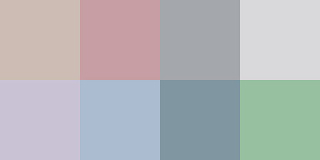Recently I was studying some Tom and Jerry pan backgrounds which inspired me to put together some thoughts about screen directions and geography in these cartoons. It’s astonishing how little has to be correct in terms of background continuity as long as the few recognizable elements aren’t popping up in completely unexpected spots. In short, anything goes, as long as screen directions are consistent and eyelines match.
The Milky Waif (released May 1946 as the 24th Hanna-Barbera T&J-short) is one of those censored* shorts that originally included blackface gags and derogatory slang imitations. If you haven’t seen it in a while, I’m sure you’ll find it somewhere around the web. The basis of my analysis is the version released on DVD in Europe on the second disc of “Tom and Jerry Collection” where almost all of them appear in chronological order. Although it might hardly be the most original or well animated of the lot, I have chosen this short because of its clearly limited indoor setting. It has become fairly well-known for the first appearance of the gray baby mouse character “Nibbles” who became Jerry’s longest running sidekick and ally.
The censored version at hand contains 67 shots (not counting any title cards and logos) for which 38 backgrounds seem to have been used. As could be expected in a cat-chases-mouse cartoon there are some rather long pans among them.
First I’d like to sort out the relevant parts of the set: there is the iconic mousehole, then we have an equally iconic tiled kitchen floor, there’s a fridge (that is never opened, it just prevents us from getting lost in the kitchen), there are green stools all around. In the nearby living room there’s a blue carpet on a beige floor.
These design elements are so iconic that mock 40s cartoons like Roger Rabbit are drawing on our unconscious knowledge of cartoons:
As movable props we have a clearly recognizable yellow bowl of milk, a few straws, a red hammer, a frying pan, a milk bottle, some books and a fly swatter. In the finale, Jerry uses a garbage can and a mallet.
As you might have noticed yourself, the colors are different in each available version of these shorts. I do not usually color correct them for analysis (at least not without indication) because it is important to me that the source of the images remains identifiable. In other words, I’m analyzing what is there and not what I believe should be or once was there.
Colors of the same backgrounds and characters vary considerably from shot to shot due to aperture and lighting. It’s important that in the case of these transfers we don’t read too much into such visible changes. They are the product of getting evenly lit shots (or faded prints) rather than subtly planned effects. So the following color swatches represent general color choices only.
Background colors in these 40s shorts are always softer than the characters because they are painted in water colors. The watercolor kitchen for example is made up of soft pastel colors:
As opposed to the strong and opaque cel paint of the characters (this overview is deceiving because the strong body color should take much more space than the other colors):
Jerry Tom
(slightly reddish probably due to fading print)
The prop colors (cel paint, of course, not water color) are even more saturated than the characters’ brown/orange and gray/blue.
* for those interested in the uncut version (which you’ll find on youtube), wikipedia’s plot synopsis is accurate:
"Jerry and Nibbles hide in a closet, while Tom hammers on the door. Seeing a chance to use deception, Jerry uses a container of nail polish he discovers to disguise himself and Nibbles as a pair of black people. Emerging from the closet, Jerry, dressed in headscarf and in blackface, greets Tom: "How you doin', Mister Tom?" and beckons Nibbles, his "honey child," to hurry up. Out comes Nibbles, also in blackface and wearing a headscarf. However, the disguise is revealed when Nibbles' diaper falls down, exposing his tail and gray fur. The chase continues, eventually leading to Jerry grabbing a frying pan and hitting Tom full in the face with it, knocking him out.”
The end cut happens right after the last frame of disguised Nibbles running through, thus only leaving in the frying pan banging in Tom's face.













2 comments:
Great analysis Oswald. When you compose the pans like that it seems ridiculous how long and repetitive they are. Amazing how unnoticeable this is when viewing the shorts.
I'd be interested to hear your comments on my own: http://onanimation.com/?p=2038
A such nice blog Oswald ! Thank you for sharing :)
Post a Comment